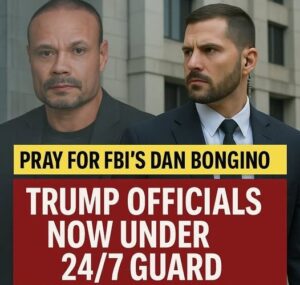Pray for Dan Bongino: Inside the Alarming Threats That Put Him Under 24/7 Guard

In a political climate where tension is no longer confined to debate stages or press briefings, the personal safety of high-profile figures has become a pressing national concern. For Dan Bongino, the well-known conservative commentator, former Secret Service agent, and now Assistant Director of the FBI, that concern has escalated to the point of full-time security.
What was once a distant concern for public figures has now become a daily reality: threats aren’t just abstract anymore—they’re real, they’re targeted, and they’re increasing in severity. Bongino, long known for his outspoken support of Donald Trump and hardline positions on law enforcement and national security, is now living under 24/7 protection. But he’s not the only one.
A Government on Guard
CBS News recently confirmed that Bongino is being protected around the clock—at FBI headquarters, during public appearances, and even at his own residence. The operation isn’t minor. Sources inside the Department of Homeland Security say that the security detail includes dozens of agents operating on a rotating schedule, all coordinated to respond to immediate threats.
Joining him under constant surveillance is Tom Homan, the former acting Director of Immigration and Customs Enforcement (ICE) and currently the lead immigration advisor under the Homeland Security umbrella. Both men have been the focus of public ire due to their uncompromising stances on immigration and national security, often appearing on conservative news outlets to push back against left-wing policies and media narratives.
But with increasing prominence comes increasing danger.
The High Price of Protection
The cost of this kind of protection isn’t cheap. Government insiders estimate that nearly $1 million per month is being spent to ensure the safety of these two men. That figure includes travel expenses, accommodations, specialized equipment, and salaries for the agents assigned to them. While some critics are calling the measure excessive, law enforcement officials stress that the threats they’re facing are anything but trivial.
“This isn’t about paranoia or dramatics,” said one DHS official who spoke on condition of anonymity. “This is about protecting lives. The hostility is real. The threats are specific. And they’re escalating.”
Indeed, DHS Assistant Secretary Tricia McLaughlin has publicly confirmed that both Bongino and Homan have been the targets of what she described as “serious and credible threats,” with a significant spike in the last three months.
“These are not vague insults,” McLaughlin said. “These are individuals posting addresses, encouraging violence, and in some cases, identifying family members. That’s not freedom of speech. That’s targeted incitement.”
Online Rage, Real-Life Risks
The rise in threats appears to be fueled in part by a digital mob mentality—an environment where viral outrage, doxxing, and politically charged misinformation can escalate quickly and dangerously. Left-leaning activists and influencers have been accused of publishing personal details about both Bongino and Homan online, while encouraging followers to confront them in public or protest outside their homes.
Tom Homan, in particular, has faced an intense wave of hostility. Known for his fiery defenses of immigration enforcement, Homan has seen protestors arrive on his front lawn, chanting slogans and filming his property. His family members have received disturbing messages. And after a surge of posts online that appeared to celebrate the idea of physical violence against him, DHS responded by ramping up his protection status.
The FBI has not released the full extent of the threats against Bongino, but insiders confirm that encrypted messages and private online groups have referenced him by name, prompting a swift escalation in security measures.
A Divided Response
Predictably, the reaction to this high-level security effort has split along ideological lines. Critics on the left, including former FBI official and MSNBC commentator Frank Figliuzzi, have suggested that the protection is being politicized.
“Is this truly about safety?” Figliuzzi questioned during a recent NBC News segment. “Or is this a way to manufacture a sense of martyrdom among political allies?”
But Bongino pushed back hard on that notion.
Taking to social media platform X, Bongino posted:
“Because of the sensitivity of what the FBI deals with, both the Director and I have to be circumspect in what we can make public. Bad guys read this stuff too. Neither one of us came here to play games… Measure us by results. You will see them. But just because you don’t see something happening right this second, doesn’t mean it isn’t happening.”
His message struck a chord with supporters who see the growing animosity toward conservative public figures as part of a broader campaign of suppression and intimidation.
The Bigger Picture: Free Speech or Incitement?
At the heart of the debate is a larger question: where is the line between protest and incitement? Civil rights advocates warn against government overreach and the chilling effect that enhanced surveillance or security measures might have on dissent.
But for officials like Bongino and Homan, the distinction seems painfully clear.
“There’s a difference between holding a sign and telling someone where a man’s daughter goes to school,” said McLaughlin. “And we’re seeing more and more of the latter.”
This isn’t just a political issue anymore—it’s a national one. As the American landscape becomes increasingly divided, and rhetoric grows more violent, government officials, regardless of affiliation, may need to grapple with a grim new reality: doing your job could cost you your peace of mind, your privacy, or even your life.

Final Thoughts
Dan Bongino’s story is no longer just about one man with strong opinions. It’s now a reflection of how polarized the nation has become. Whether the $1 million-per-month protection plan is justified or not, the fact remains that this kind of threat level—once reserved for war zones and cartel targets—is now part of domestic political life in the United States.
One thing is certain: the era of verbal disagreement has given way to personal risk. And the costs—emotional, financial, and political—are only growing.